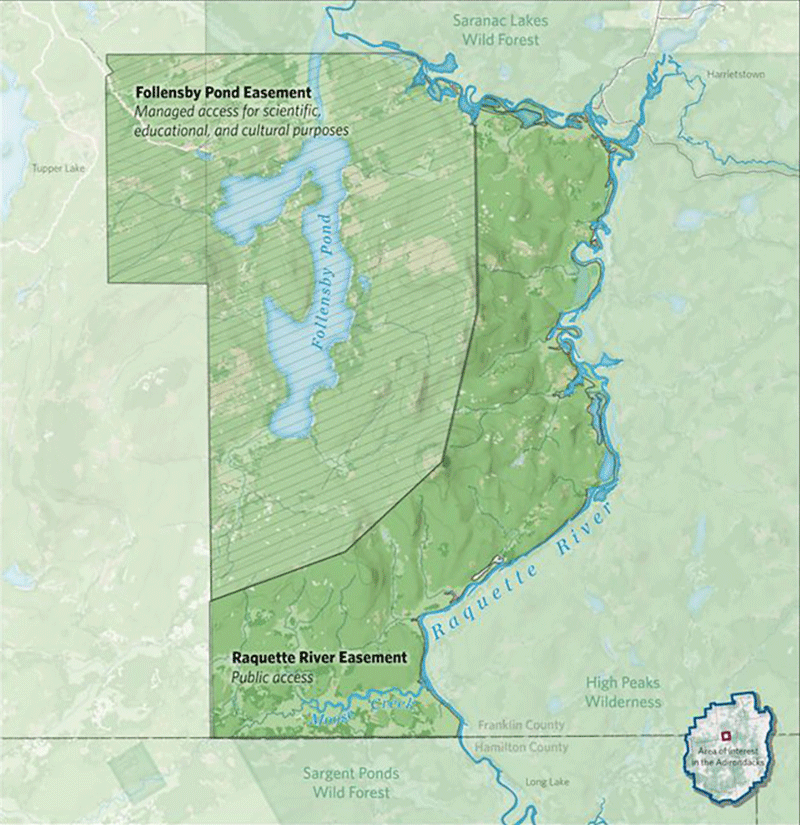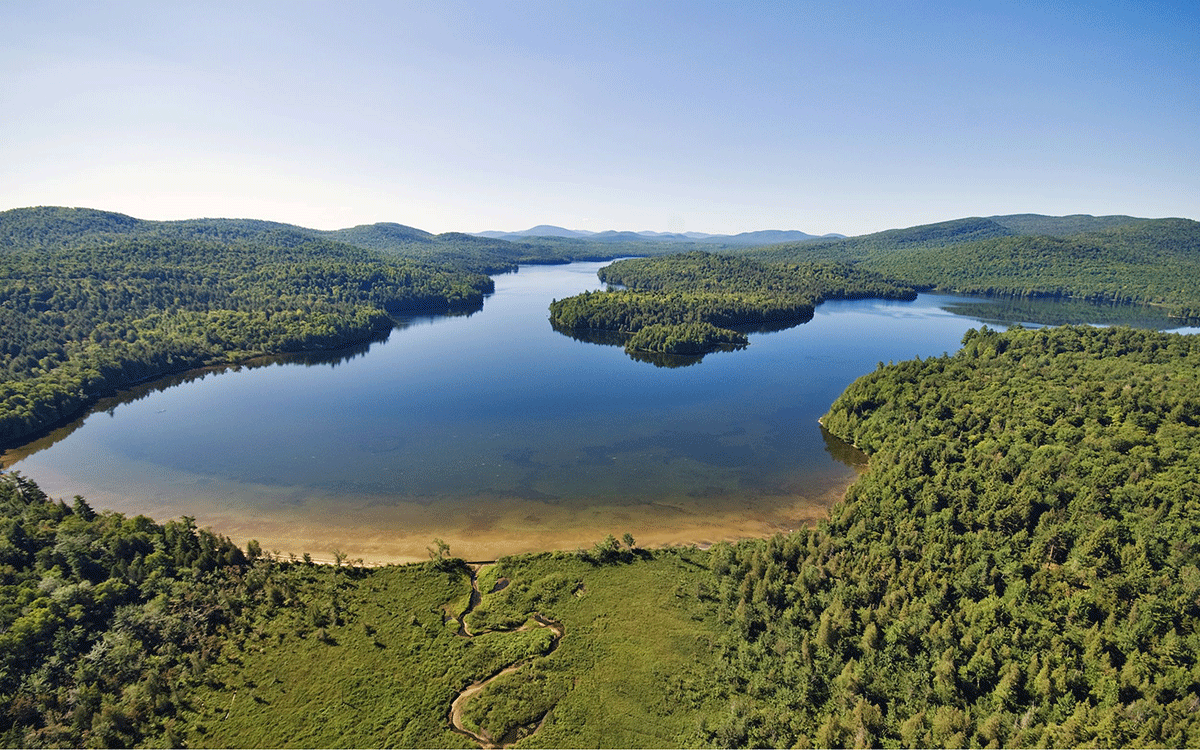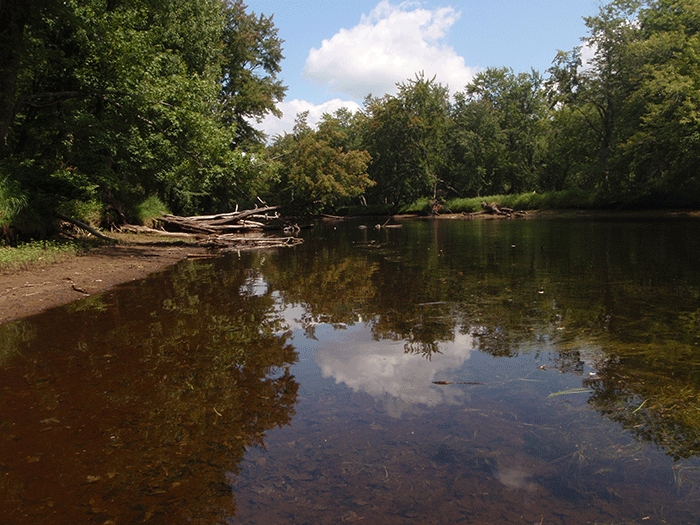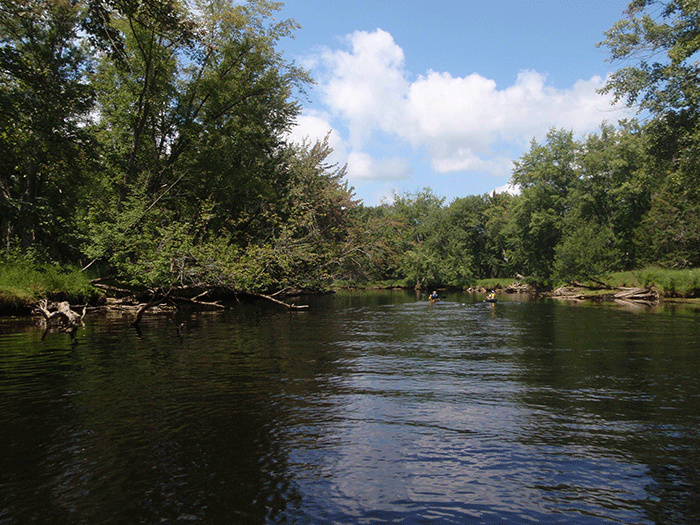The Nature Conservancy announced that it has worked out two new conservation easements with the State of New York to protect for all time the 14,645-acre Follensby Pond tract. These easements will protect the world class lake trout fishery in the 958-acre deep water of the lake, which scientists see as a vital refuge area for lake trout as the climate warms. These easements will also provide new recreational opportunities, such as canoeing on the long-closed Moose Creek, north of Raquette Falls, and will protect 10 miles of the west bank of the Raquette River and provide new outdoor recreational opportunities on these lands.
Public access to Follensby Pond will be tightly controlled with details to be developed. It’s unclear what kind of public access, if any, will be allowed to the historic lake.
The Department of Environmental Conservation (DEC) and The Nature Conservancy (TNC) have agreed in concept to two easements (see map below) that are expected to be finalized by the end of 2024. The Nature Conservancy said these easements “will achieve a crucial balance between providing enhanced recreational opportunities in an area adjacent to State Forest Preserve lands and protecting a globally rare ecosystem while recognizing the long-term relationships that Indigenous People have with the region.”

This map show the two conservation easements that will be purchased by the State of New York from The Nature Conservancy. This map is used here courtesy of TNC. The picture above is also courtesy of TNC and is a shot of Follensby Pond by Adirondack photographer Carl Heilman.
Raquette River Recreational Access: The Raquette River conservation easement (darker green on the map above) totals 5,985 acres on the west side of the river that includes the Moose Creek watershed. The Raquette River is one of the most popular for canoeing and camping in the Adirondacks. The eastern side of the river is protected the 275,000-acre High Peaks Wilderness Area and includes dozens of campsites. Forest Preserve between The Crusher Boat Launch and Axton Landing canoe launch Las includes lands in the Saranac Lake Wild Forest Area. The easement will allow “camping, picnicking, hiking, hunting, and fishing.” A Recreation Management Plan (RMP) will be developed by the DEC for this conservation easement. This easement will also continue to allow existing private hunting leases.
Follensby Pond Research Preserve Easement and Consortium: This deal includes a second conservation easement totaling 8,660 acres (area around the pond in the map above), which includes the entire Follensby Pond and its watershed. Public access will be tightly controlled to Follensby Pond. The site is historic as it was visited in1858, by Ralph Waldo Emerson and a group of other artists and transcendentalists thinkers. The site was also a part of a successful bald eagle reintroduction in 1983. The main focus of this easement will be long-term research on freshwater research. Follensby Pond sits at an elevation of 1,545 feet and has a maximum depth of 102 feet, which means the pond maintains a stable cold-water fishery. The Nature Conservancy says that Follensby Pond is also “one of only nine remaining intact lakes in the lower 48 states that still supports a rare, old-age population of wild lake trout which has been relatively unfished for many years. These collective features provide scientists a rare opportunity to study an unexploited population and learn about how climate change and other environmental influences may impact such a species over time.” This research effort will include a number of partners.
Click here to read The Nature Conservancy press release.
Protect the Adirondacks Chair Chuck Clusen said “Hats off to The Nature Conservancy and the DEC for reaching an agreement to protect these important lands for the long-term. We look forward to working with TNC, the State, and others as plans are developed to manage these two tracts of lands where the People of the State of New York will soon own conservation easements.”
Center for Native Peoples and the Environment: The easement will also facilitate a partnership between TNC and the Center for Native Peoples and the Environment at SUNY-ESF. The Follensby Pond tract will “offer managed access for scientific and educational purposes and for Indigenous Peoples’ cultural practices, including ceremonies, gathering, and foraging.” The Director of the Center for Native Peoples and the Environment, Dr. Robin Wall Kimmerer, author of Braiding Sweetgrass, said, “There is growing evidence from all around the world that biodiversity flourishes under Indigenous stewardship. With our partners, we look forward to creating opportunities for a productive collaboration between Traditional Ecological Knowledge and conservation science based on mutual respect, reciprocity and shared access. Land care which reflects Indigenous perspectives and priorities has the potential to enhance the wellbeing of land and cultures in the extraordinary landscape of Follensby Pond.”
Governor Kathy Hochul said “New Yorkers and visitors to this special region of the Adirondacks have long recognized the singular beauty and significance of Follensby Pond and the Raquette River. In collaboration with The Nature Conservancy and many partners, we are preserving a unique natural resource so that all New Yorkers can enjoy this treasured and historic region for generations to come.”
State Senator Pete Harckham, Chair of the Senate Environmental Conservation Committee, said “This new agreement to protect nearly 15,000 acres in the Adirondacks stands as a triumph for land conservation here in New York. It is imperative that we safeguard our pristine forests and natural resources for future generations, and this unique public – private partnership between the Nature Conservancy and the state’s Department of Environmental Conservation is a model achievement in this regard.”
Assemblymember Deborah J. Glick, Chair of the Assembly Environmental Conservation Committee, said “The permanent protection of nearly 15,000 acres in and around the Follensby Pond and the Raquette River in the Adirondacks is great news for conservationists, researchers, outdoor enthusiasts, and all New Yorkers. Equally important is the protection of the freshwater preserve of the unique habitat of the pond, which will provide us with a valuable outdoor research laboratory. The pandemic has reminded so many people of the wonderful outdoor resources available to us, and this conservation easement will provide new fresh air opportunities, from boating to hiking and more. Projects like this remind us of how critical continued investment in the Environmental Protection Fund is for the protection of ecologically unique areas and preservation of open space.”
Basil Seggos, Commissioner of the Department of Environmental Conservation, said “Securing more than 14,600 acres of critically important ecosystems is a win-win for conservation and for all New Yorkers. In recognition of the longstanding stewardship by Indigenous Peoples and in the spirit of Emerson and the great thinkers of two centuries ago, New York State and The Nature Conservancy are bringing together a consortium of leading scientific minds to study a waterbody that has remained relatively untouched for more than a century. Follensby Pond and its associated watershed will serve as a living laboratory for scientific study by leading public and private institutions. Together, the easements provide a unique combination of enhanced recreational and globally significant research opportunities, thereby providing a sound balance between conservation and recreation. DEC is excited to continue collaborating on this historic environmental, scientific, cultural, and economic opportunity.”








